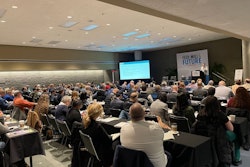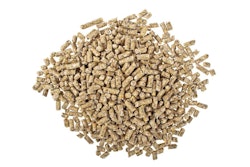
How do you know if your feed mill equipment cleanout procedures are effectively removing veterinary drug residue?
To avoid veterinary drug carryover from a batch of medicated feed to a subsequent batch, feed mills need to have a cleanout procedure and a process to verify that the procedure has been carried out successfully, according to Philip Hamlow, staff scientist at Eurofins.
Hamlow spoke January 25 during a TECHTalk at the International Production & Processing Expo in Atlanta.
Effective mixer cleanout saves time and maximizes productivity, he said. But if the cleanout is insufficient, there can be consequences. These include medication carryover resulting in unsafe residues in human food or animal feed for an unintended species.
Cleanout procedures can include running a batch of unmedicated feed through the system to flush it out, using compressed air, spraying out the mixer with water or scraping with shovels and brooms.
A cleanout validation plan will show whether the cleanout procedures put in place are effective.
“Cleanout validation, if done well, starts from a plan,” he said. “The objective of this validation plan is to use data to demonstrate that your cleanout procedures work. It also, from the business perspective, gives you confidence that you’re avoiding unsafe contamination of feed.”
That plan may start with a protocol, which becomes the outline for the steps that will be completed along the way, such as mixing, cleaning, sampling and testing. Each of these steps should be documented.
“You have a plan, apply the plan, know the results. Contract with a testing lab, or your own lab or a state lab to support you, and then apply the validation plan as you’ve outlined it,” Hamlow said.
It is also critical to understand what testing will be done and that the correct samples and sample sizes are collected.
“You can’t do this testing with just a little thimble full of feed. You need the appropriate quantity,” he said. “And then sometimes the hard part is considering the test results and putting some meaning on them.”
If necessary, he added, repeat the test in order to have data that demonstrates that the cleanout process was successful.
Also important is to what exactly the validation test is looking for, i.e. the existence of a drug vs. the absence of it.
“Methods are often developed to test for a drug, not for the absence of a drug. And so that different perspective is important to make certain that you do the right testing and have the right facility or laboratory that can support you with the correct testing,” Hamlow said. “In many cases, when you’re looking for the drug, it’s relatively easy because they know what’s in there. There’s a defined concentration. And then if you’re looking for the absence to demonstrate that you’ve cleaned out the mixer, you now are expecting or hoping to see zero, or no detectable amount of drug. But it does challenge the analytical techniques and it can challenge the laboratory to give the right answer that says, ‘We didn’t find any,’ … or, if we did find some, perhaps assist in understanding, is it important?”














